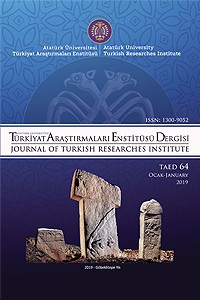Öz
Anahtar Kelimeler
Kaynakça
- Ali Efendi, (1976). İstanbul’da Elli Yıllık Önemli Olaylar, İstanbul: Sander Yayınları. Basiret, Hakkı Tarık Us Koleksiyonu, Yer No: 0017. İ.B.B. Atatürk Kitaplığı Demirbaş No: NS 0211. BOA, İ.MMS, 50/ 2154, H. 03.08.1291. BOA, MF-MKT, 30/ 76, H. 16.06.1292. Çaylak, Hakkı Tarık Us Koleksiyonu, Yer No: 2132. Demirkol, Gökhan. (2016). “Tanzimat Mizahının Sonu: 1877 Matbuat Kanunu Tartışmaları ve Osmanlı’da Mizah Dergilerinin Kapanması”, Hitit Üniversitesi Sosyal Bilimler Enstitüsü Dergisi, Yıl:9, Sayı:2, 687-710. Demirkol, Gökhan. (2018). “Tanzimat Dönemi Türkçe Mizah Dergileri Bibliyografisi (1870-1877)”, 3. Uluslararası Bilimsel Araştırmalar Kongresi Bildiri Kitabı, Ankara: Berikan Yayınevi, ss. 239-248 Düstur, Tertip 1/3, 11 Şevval 1290 (02 Aralık 1873). Hayal, Hakkı Tarık Us Koleksiyonu, Yer No: 099/2. İkdam, Hakkı Tarık Us Koleksiyonu, Yer No: 0005. İ.B.B. Atatürk Kitaplığı Demirbaş No: NS0907. İnuğur, Nuri. (2005). Basın ve Yayın Tarihi, İstanbul: Der Yayınları. Jeanneney, Jean-Noel. (2006). Başlangıcından Günümüze Medya Tarihi, İstanbul: Yapı Kredi Yayınları. Kahkaha, Hakkı Tarık Us Koleksiyonu, Yer No: 1146. Latife, Hakkı Tarık Us Koleksiyonu, Yer No: 237/1. Meddah, Hakkı Tarık Us Koleksiyonu, Yer No: 0237/2. Öztürk, Özer. (2014). “1875 Moratoryumundan Düyun-ı Umumiye İdaresi’ne Osmanlı Ekonomisi”, Sultan II. Abdülhamid Sempozyumu Bildirileri, Ankara: Türk Tarih Kurumu Yayınları, Cilt 2, 7-38. Sâlname-i Devlet-i Aliye-i Osmaniye, (1874). İstanbul: Darü’t-tıbatü’l Amire. Tiyatro, Hakkı Tarık Us Koleksiyonu, Yer No: 1316. Yalçın, Hüseyin Cahit. (2002). Edebiyat Anıları, İstanbul: Türkiye İş Bankası Kültür Yayınları. Yerlikaya, İlhan. (1994). Basiret Gazetesi, Van: Yüzüncü Yıl Üniversitesi Fen-Edebiyat Fakültesi Yayınları.
Öz
The ‘Resm-i Damga Nizamnamesi’, which went into effect in 1875, brought a great burden on the Ottoman Press economically. The newspapers and magazines that are required by the ordinance are obliged to affix ‘2 para’ stamps to each copy as stamp tax. Media of that time called this application as ‘stamp tax’ referring to stamped stamps. The stamp tax imposed for twenty-five years from the date of the abolition in 1900 is not only a heavy burden on the economy for the press in the period it was applied but also has importance in terms of preparing the ground for the first press strike in the Turkish Press History. Humour magazines, which were closed in 1877 in the Ottoman Empire, came to the forefront as periodical publications that were most affected by stamp tax, although they were subject to stamp tax for a short period of two years.
Within the scope of the study, between 1874 and 1877, how humour magazines were influenced by stamp tax, their approach to stamp tax, and the application of stamp tax and the cases where the magazines live, have been examined. The stamp tax is an application that prevented the development of Turkish Humour Press between 1874-1877. The absence of the study on the stamp tax in the literature makes this study important.
Anahtar Kelimeler
Kaynakça
- Ali Efendi, (1976). İstanbul’da Elli Yıllık Önemli Olaylar, İstanbul: Sander Yayınları. Basiret, Hakkı Tarık Us Koleksiyonu, Yer No: 0017. İ.B.B. Atatürk Kitaplığı Demirbaş No: NS 0211. BOA, İ.MMS, 50/ 2154, H. 03.08.1291. BOA, MF-MKT, 30/ 76, H. 16.06.1292. Çaylak, Hakkı Tarık Us Koleksiyonu, Yer No: 2132. Demirkol, Gökhan. (2016). “Tanzimat Mizahının Sonu: 1877 Matbuat Kanunu Tartışmaları ve Osmanlı’da Mizah Dergilerinin Kapanması”, Hitit Üniversitesi Sosyal Bilimler Enstitüsü Dergisi, Yıl:9, Sayı:2, 687-710. Demirkol, Gökhan. (2018). “Tanzimat Dönemi Türkçe Mizah Dergileri Bibliyografisi (1870-1877)”, 3. Uluslararası Bilimsel Araştırmalar Kongresi Bildiri Kitabı, Ankara: Berikan Yayınevi, ss. 239-248 Düstur, Tertip 1/3, 11 Şevval 1290 (02 Aralık 1873). Hayal, Hakkı Tarık Us Koleksiyonu, Yer No: 099/2. İkdam, Hakkı Tarık Us Koleksiyonu, Yer No: 0005. İ.B.B. Atatürk Kitaplığı Demirbaş No: NS0907. İnuğur, Nuri. (2005). Basın ve Yayın Tarihi, İstanbul: Der Yayınları. Jeanneney, Jean-Noel. (2006). Başlangıcından Günümüze Medya Tarihi, İstanbul: Yapı Kredi Yayınları. Kahkaha, Hakkı Tarık Us Koleksiyonu, Yer No: 1146. Latife, Hakkı Tarık Us Koleksiyonu, Yer No: 237/1. Meddah, Hakkı Tarık Us Koleksiyonu, Yer No: 0237/2. Öztürk, Özer. (2014). “1875 Moratoryumundan Düyun-ı Umumiye İdaresi’ne Osmanlı Ekonomisi”, Sultan II. Abdülhamid Sempozyumu Bildirileri, Ankara: Türk Tarih Kurumu Yayınları, Cilt 2, 7-38. Sâlname-i Devlet-i Aliye-i Osmaniye, (1874). İstanbul: Darü’t-tıbatü’l Amire. Tiyatro, Hakkı Tarık Us Koleksiyonu, Yer No: 1316. Yalçın, Hüseyin Cahit. (2002). Edebiyat Anıları, İstanbul: Türkiye İş Bankası Kültür Yayınları. Yerlikaya, İlhan. (1994). Basiret Gazetesi, Van: Yüzüncü Yıl Üniversitesi Fen-Edebiyat Fakültesi Yayınları.
Ayrıntılar
| Birincil Dil | Türkçe |
|---|---|
| Bölüm | Makaleler |
| Yazarlar | |
| Yayımlanma Tarihi | 31 Ocak 2019 |
| Yayımlandığı Sayı | Yıl 2019 Sayı: 64 |


